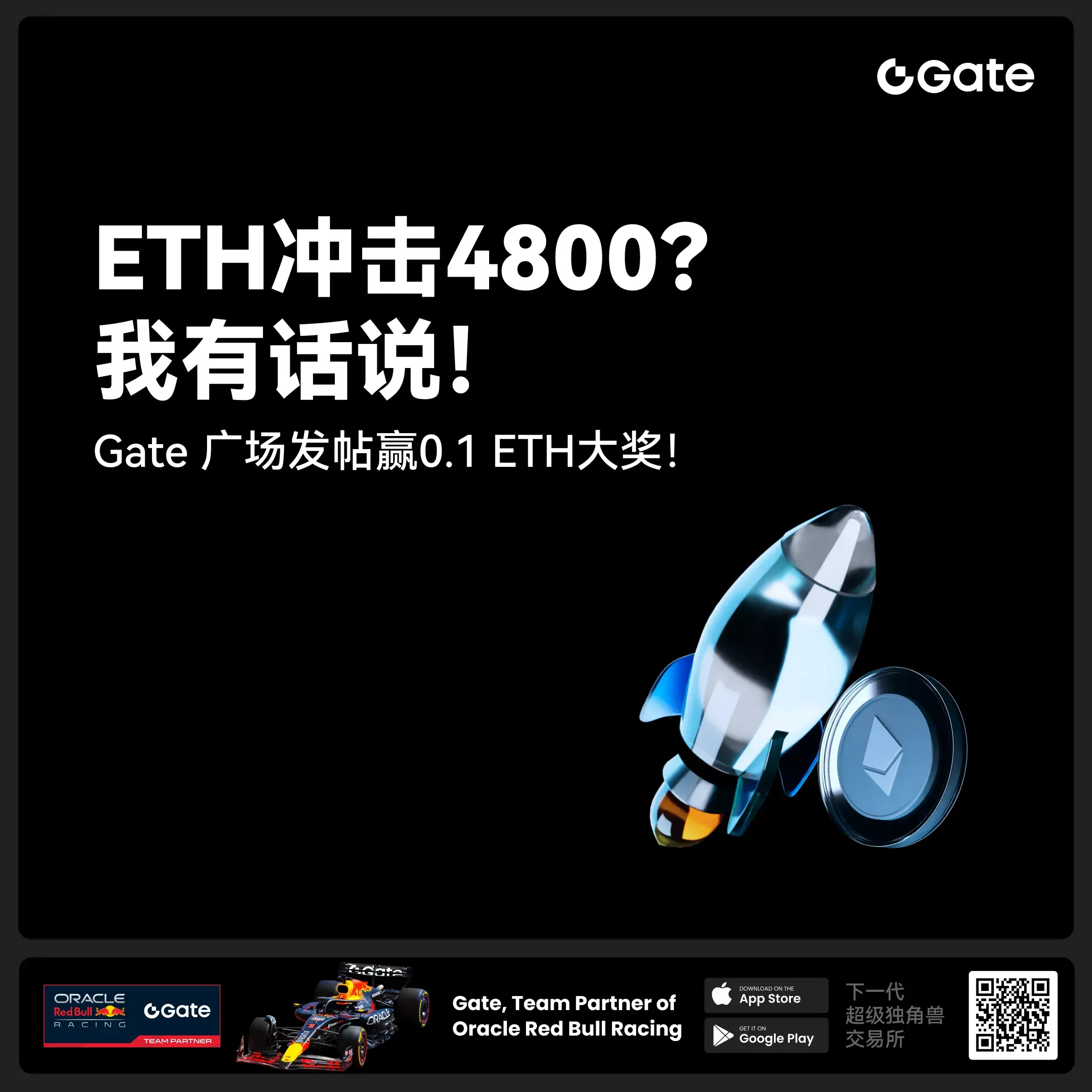- 话题
16152 热度
9994 热度
38597 热度
43296 热度
16035 热度
16926 热度
5913 热度
2628 热度
94778 热度
- 10我的Gate时刻
27059 热度
- 置顶
- 📢 ETH冲击4800?我有话说!快来“Gate广场”秀操作,0.1 ETH大奖等你拿!
牛市预言家,可能下一个就是你!想让你的观点成为广场热搜、赢下ETH大奖?现在就是机会!
💰️ 广场5位优质发帖用户+X浏览量前5发帖用户,瓜分0.1 ETH!
🎮 活动怎么玩,0门槛瓜分ETH!
1.话题不服来辩!
带 #ETH冲击4800# 和 #ETH# 在 广场 或 K线ETH下 围绕一下主题展开讨论:
-ETH是否有望突破4800?
-你看好ETH的原因是什么?
-你的ETH持仓策略是?
-ETH能否引领下一轮牛市?
2. X平台同步嗨
在X平台发帖讨论,记得带 #GateSquare# 和 #ETH冲击4800# 标签!
把你X返链接提交以下表单以瓜分大奖:https://www.gate.com/questionnaire/6896
✨发帖要求:
-内容须原创,字数不少于100字,且带活动指定标签
-配图、行情截图、分析看法加分,图文并茂更易精选
-禁止AI写手和灌水刷屏,一旦发现取消奖励资格
-观点鲜明、逻辑清晰,越有料越好!
关注ETH风向,创造观点价值,从广场发帖开始!下一个牛市“预言家”,可能就是你!🦾🏆
⏰ 活动时间:2025年7月18日 16:00 - 2025年7月28日 23:59(UTC+8)
【立即发帖】 展现你的真知灼见,赢取属于你的ETH大奖!
- 🎉 #Gate Alpha 第三届积分狂欢节 & ES Launchpool# 联合推广任务上线!
本次活动总奖池:1,250 枚 ES
任务目标:推广 Eclipse($ES)Launchpool 和 Alpha 第11期 $ES 专场
📄 详情参考:
Launchpool 公告:https://www.gate.com/zh/announcements/article/46134
Alpha 第11期公告:https://www.gate.com/zh/announcements/article/46137
🧩【任务内容】
请围绕 Launchpool 和 Alpha 第11期 活动进行内容创作,并晒出参与截图。
📸【参与方式】
1️⃣ 带上Tag #Gate Alpha 第三届积分狂欢节 & ES Launchpool# 发帖
2️⃣ 晒出以下任一截图:
Launchpool 质押截图(BTC / ETH / ES)
Alpha 交易页面截图(交易 ES)
3️⃣ 发布图文内容,可参考以下方向(≥60字):
简介 ES/Eclipse 项目亮点、代币机制等基本信息
分享你对 ES 项目的观点、前景判断、挖矿体验等
分析 Launchpool 挖矿 或 Alpha 积分玩法的策略和收益对比
🎁【奖励说明】
评选内容质量最优的 10 位 Launchpool/Gate - 和其他领域不一样的是:你想支持一个 Web3 游戏项目,你必须要「双投」——既要投时间,也要投钱。

- 🎉【Gate 3000万纪念】晒出我的Gate时刻,解锁限量好礼!
Gate用户突破3000万!这不仅是数字,更是我们共同的故事。
还记得第一次开通账号的激动,抢购成功的喜悦,或陪伴你的Gate周边吗?
📸 参与 #我的Gate时刻# ,在Gate广场晒出你的故事,一起见证下一个3000万!
✅ 参与方式:
1️⃣ 带话题 #我的Gate时刻# ,发布包含Gate元素的照片或视频
2️⃣ 搭配你的Gate故事、祝福或感言更佳
3️⃣ 分享至Twitter(X)可参与浏览量前10额外奖励
推特回链请填表单:https://www.gate.com/questionnaire/6872
🎁 独家奖励:
🏆 创意大奖(3名):Gate × F1红牛联名赛车模型一辆
👕 共创纪念奖(10名): 国际米兰同款球员卫衣
🥇 参与奖(50名):Gate 品牌抱枕
📣 分享奖(10名):Twitter前10浏览量,送Gate × 国米小夜灯!
*海外用户红牛联名赛车折合为 $200 合约体验券,国米同款球衣折合为 $50 合约体验券,国米小夜灯折合为 $30 合约体验券,品牌抱枕折合为 $20 合约体验券发放
🧠 创意提示:不限元素内容风格,晒图带有如Gate logo、Gate色彩、周边产品、GT图案、活动纪念品、活动现场图等均可参与!
活动截止于7月25日 24:00 UTC+8
3
- 🔥 Gate广场 #GateAlpha积分节# 晒单狂欢开启!
带 #Gate Alpha交易分享# ,晒出你的Alpha第三届积分节高光交易,瓜分 $100 幸运奖池!
🎁 10名幸运晒图用户 * 10 USDT
📅 7月4日 12:00 -7月20日 24:00 UTC+8
别忘了,Alpha积分节主奖池高达百万美元,快来交易 + 晒图双重赢奖!
活动详情:https://www.gate.com/announcements/article/45908
比特币矿商Hut 8策略解析!低成本挖矿、精准布局,如何平衡风险
图源:ForesightNews
那斯达克上市比特币矿企 Hut 8 的执行长 Asher Genoot,近日在社交平台 X 上畅谈了公司战略性比特币储备的深层逻辑。这家矿企凭借其创新性的营运模式,将资本管理与营运扩充功能紧密结合,展现了对长期价值创造的野心。其策略核心在于,通过低成本生产和市场购买增加比特币储备,同时专注于高报酬率项目的资本分配,推动规模和基础设施的不断扩张。
这一策略令人印象深刻,但也揭示了一个更大的问题:在极具波动性的市场环境中,如何为矿企设定一条安全边界,以在激进扩张与财务稳定之间保持微妙的平衡?Aiying FundInsight 将从 Hut 8 的现实出发,分析其战略中的潜在风险及模拟其风险边界值。
一、飞轮逻辑分析
图源:ForesightNews
一切始于低成本、高效率的比特币生产。Hut 8 借助先进的挖矿设备、优化的算力管理以及低成本可再生能源,将挖矿成本压缩至产业平均水准以下。具体而言,公司通过与能源供应商的长期合作以及对辅助需量反应计划的参与,将每枚比特币的生产成本控制在 31,482 美元,远低于大多数竞争对手。
这种低成本生产不仅帮助 Hut 8 在价格波动中保持竞争力,还为其储备策略提供了源源不断的低价资产输入。而随着 2025 年第一季度新矿机的上线,公司预计算力进一步提升,单位生产成本将再次下降,效率将达到新高度。
在低成本生产之外,Hut 8 的飞轮逻辑中另一个关键齿轮是战略市场购买。当市场出现机会(如价格低谷)时,公司果断出手,以高溢价获取比特币储备。尽管 2024 年 12 月的每枚 101,710 美元的购买价格较高,但这种高价行为背后的逻辑是,扩大储备总量可以显著增强企业的财务灵活性。而且【解读】美国财务会计准则委员会公允价值准则正式实施:比特币作为企业储备资产的「标准选项」又近了一步。
通过这一策略,Hut 8 不仅提升了综合储备规模(目前达到 10,096 枚),还将储备的综合成本维持在 24,484 美元 / 枚的低水准。这种「低成本生产 + 战略购买」的双轨机制,不仅帮助公司锁定了目前的市占率,还为下一步操作提供了更多可能性。
储备是整个飞轮效应的核心。Hut 8 的比特币储备并非被动资产,而是一个可以灵活运用的资本工具。公司将其储备作为优化资产负债表的重要武器,通过多种手段发挥杠杆效应,包括:
选择权策略:在市场高位锁定收益,降低波动性对财务的冲击;
抵押融资:用储备作为担保,获取资金支持营运扩充功能;
市场抛售:在需要现金流时,通过储备变现填补资金缺口。
这一策略不仅增强了企业在资本市场中的抗风险能力,也为电力基础设施建设和数位平台开发等资本密集型项目提供了强有力的支持。
低成本生产与战略购买提供了稳定的资产输入,而储备的灵活管理则为公司注入了流动性。这三者形成了 Hut 8 飞轮效应的基本循环:
生产驱动储备:通过高效挖矿将比特币储备扩充功能;
储备驱动资本:利用储备灵活融资,支撑营运扩充功能;
资本驱动生产:融资所得被重新投入到新设备和基础设施扩建中,从而进一步提升生产效率。
这种自循环系统在 Hut 8 的策略中并非静态,而是通过调整储备规模和融资方式不断优化。例如,在比特币价格上涨时,公司通过高位减持获得资金,在价格低谷时重新回购,最大化储备的资本报酬率。
Hut 8 计划于 2025 年第一季度上线的高效能矿机,将成为飞轮效应的重要加速器。这些设备不仅将进一步降低挖矿成本,还会显著提高公司的总算力,巩固其在市场中的竞争优势。此外,公司正积极布局数位基础设施建设和高性能计算平台,这种多元化发展将为飞轮效应引入更多动力源,从而推动业务价值跨越式成长。
二、飞轮效应的风险状况与边界值分析
Hut 8 的「飞轮效应」战略展示了其强大的扩充功能能力和市场敏锐度,但这一模式也不可避免地增加了企业在多个层面的风险。结合现有数据和产业特性,以下是 Aiying FundInsight 对 Hut 8 目前风险状况及预估风险边界值的综合推理分析。风险的逻辑在前面的文章有提到过《年 2450% 涨幅的日本版 MicroStrategy:Metaplanet 零利率债券背后的比特币杠杆游戏》。
Hut 8 目前持有 10,096 枚比特币,总市值超过 10 亿美元,占公司资产的显著比例。据公开数据,10 亿美元的比特币储备占 Hut 8 总资产约 60%,显示出该储备对公司整体财务健康的重大影响。由于比特币价格的高波动性,这一储备在市场低迷期可能迅速贬值。基于现有数据,以下是关键的财务风险边界:
盈亏平衡点:Hut 8 的挖矿成本为 31,482 美元 / 枚,这意味着当比特币价格持续低于此水准时,挖矿业务将陷入亏损。
储备市值下限:若比特币价格跌至 20,000 美元 / 枚,Hut 8 的储备总市值将降至约 2 亿美元(10,096 枚 × 20,000 美元),可能对资产负债表造成显著冲击。
高成本购买压力:2024 年 12 月,公司以 101,710 美元 / 枚的价格新增 990 枚比特币。据 Hut 8 公布的公开资讯,这次购买部分资金可能通过外部融资获得,这意味着未来的融资成本将对储备资产的报酬率率产生直接影响。这部分高成本储备占总储备的约 9.8%,若市场价格长期低于 50,000 美元,将显著降低整体储备的获利能力。
Hut 8 以市场购买与低成本生产结合的方式增加储备,但两者在市场波动下可能产生矛盾。
综合储备压力:目前的综合储备成本为 24,484 美元 / 枚,这是低成本生产与市场购买的加权结果。若比特币价格长期低于这一水准,储备整体收益将变为负值。
市场流动性冲击:比特币市场的高波动性可能导致 Hut 8 在需要快速变现储备时面临资产贬值风险,例如在低点抛售储备可能无法覆盖融资需求。
Hut 8 的资本密集型扩充功能策略不可避免地依赖外部融资来支持营运和成长计划。融资成本的上升可能对其现金流和获利能力产生直接影响。
融资成本边界:假设 Hut 8 目前的债务融资成本在 6%-8% 之间(基于产业平均水准),若融资成本上升至 10% 以上,公司通过比特币储备或挖矿活动实现的资本报酬率率(ROIC,目前约为 12%-14%,基于公开的营运收益数据)可能无法覆盖融资成本,导致资本效率下降。
债务压力:高融资成本可能使 Hut 8 需要增加比特币的变现频率,从而降低储备对资产负债表的长期支持作用。
Hut 8 目前的挖矿成本控制在 31,482 美元 / 枚,主要得益于低成本能源和高效设备。然而,这种模式在以下边界下可能面临挑战:
运效率边界:如果挖矿成本因能源价格上涨或设备效率下降而突破 40,000 美元 / 枚,Hut 8 的获利能力将受到严重压缩。
地域集中风险:Hut 8 的设施主要集中在北美区域,尽管政策环境相对稳定,但缺乏地域多样性可能增加对单一区域政策或能源供给中断的依赖。
全球范围内的加密产业监管力度不断增强,包括对能耗、碳排放和挖矿活动的限制。Hut 8 的北美业务虽目前营运稳定,但政策环境的变化仍是潜在威胁。
监管成本边界:如果政策增加碳税或电力成本超过 20%,Hut 8 的挖矿利润率可能面临削减。
政策变化风险:若加拿大等主要营运区域实施更严格的能源或环保规定,Hut 8 可能需要重新布局矿场或增加设施升级支出。
Hut 8 的比特币储备被设计为灵活资产,用于支持资本密集型扩充功能计划。然而,在市场极端波动情况下,储备灵活性可能受到限制。
变现能力边界:若比特币价格跌至 20,000 美元以下,公司储备变现能力将显著下降,可能无法满足扩充功能计划所需的现金流需求。据公开揭露资讯,Hut 8 目前的现金储备为 5,000 万美元左右,这一水准虽可支持短期营运,但在极端市场环境中可能不足以完全抵消储备资产价值下跌带来的冲击。
高波动性风险:比特币价格大幅波动可能在短期内限制 Hut 8 通过储备实现融资的能力。
Aiying 艾盈结语:安全边界的设定是智慧的平衡术
通过分析 Hut 8 的实际营运数据,可以清晰地看出,其战略性比特币储备与营运扩充功能的成功,是建立在高度复杂的风险管理体系之上的。从财务健康到市场波动,从技术升级到政策布局,每一个环节都需要缜密规划与灵活调整。
设定安全边界,不仅是矿企面对高波动市场时的自我保护,更是优化资源分配与提升营运效率的核心策略。对 Hut 8 而言,只有在风险与收益之间找到精妙的平衡,才能在加密产业的大潮中屹立不倒,并持续书写价值创造的传奇。
【免责声明】市场有风险,投资需谨慎。本文不构成投资建议,使用者应考虑本文的任何意见、观点或结论是否符合其特定状况。据此投资,责任自负。
本文经授权转载自:《Foresight News》
原文作者:AY FundInsight
『比特币矿商Hut 8策略解析!低成本挖矿、精准布局,如何平衡风险』这篇文章最早发布于『加密城市』